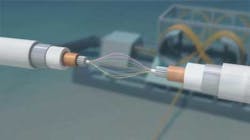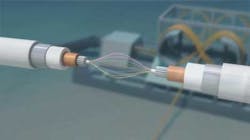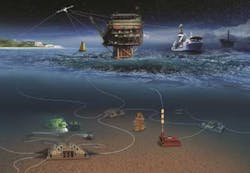Fiber-optic networks offer new high-speed communication alternative
Joe Friedman
David Pfosi
Harris CapRock Communications
High-speed communication to offshore assets is quickly becoming the next giant leap forward for the offshore oil and gas industry. As more companies capitalize on the benefits of high- speed communication to offshore platforms and vessels, dedicated subsea fiber-optic networks will continue their transition from one-off, retrofitted "nice-to-haves" to imperative, non-negotiable elements of every new and existing semi-permanent offshore asset.
In addition to their most obvious benefits—broadened and enhanced communication options for offshore crews—high-speed communication networks offer many other immediate efficiency, accuracy and safety benefits that will become the new standard. Soon, any offshore asset without a high-speed data connection will be viewed as archaic and old fashioned.
Historically, the two greatest challenges to high-speed communication offshore were the significant upfront cost and the steep learning curve of high-tech maritime communications. However, a few of the leading communications service providers, such as Harris CapRock Communications, are now poised to offer fully configured solutions with long-term leases that spread the cost over many years and multiple customers, thereby offering fees comparable to traditional Very Small Aperture Terminal (VSAT) satellite systems with better performance.
Connecting offshore platforms to land-based infrastructure via submarine fiber- optic cable links provides throughput 100 or even 1,000 times greater than traditional VSAT links at latencies of about 20-50 milliseconds. Comparatively, geosynchronous satellite transmission is more than 10 times slower because the microwave signal must travel to the satellite and back, more than 70,000 km (43,505 mi). Even at the speed of light, traveling this distance requires more than half of a second.
Other factors like signal processing speed, platform location and weather interference further slow down communication. This in turn causes echoes, distortion, and otherwise degraded quality that interferes with satellite-based audio/video connections, and have historically prohibited the use of remote applications or any other software requiring real-time connectivity. Fiber connections practically eliminate this latency and have proven to be safe and reliable in some of the harshest, most remote locations on Earth.
Once a fiber backbone is connected to one or more platforms, high-speed connectivity can be "hopped" from those connected platforms to surrounding assets using high-speed, high- reliability radio frequency (RF) links.
Directional point-to-point transmitters propagate a focused RF signal to any receiver within line of sight range with lower latency and higher throughput than the VSAT it replaced. RF can also be used to blanket a large area (up to 200 sq km [77 sq mi] or more) with high-speed connectivity.
Functionally similar to a home Wi-Fi system but on a much larger scale, this omni-directional RF blanket can be accessed by any number of vessels or other assets within the radius, enabling floating production, storage and offloading (FPSO) units, service vessels, helicopters, flotels or even emergency lifeboat capsules to access the platform's communications infrastructure.
But no matter how impressive fiber's spec sheet appears, the true value of high-speed data offshore is more than throughput, reliability and latency figures. Early adopters and savvy IT professionals know its greatest value is cost savings, both near and long term.
Improved quality of life offshore enables companies to attract and retain the newest generation of employees who consider smartphones and wireless connectivity a way of life. Just one fiber-optic link can support thousands or even millions of audio and video channels simultaneously. While resting, crew members can stream movies or video chat with their families at home, and onshore personnel can simultaneously monitor hundreds of offshore security cameras and data feeds in high definition.
The value of high-speed communications has been proven in multiple locations. In 2007 and 2008, BP created a 1,216-km (758-mi) fiber ring to serve the densely populated Gulf of Mexico. It is the longest fiber network dedicated exclusively to oil and gas in the world, and BP platforms have been capitalizing on its advantages ever since.
The Central North Sea Fibre Telecommunications Co. (CNSFTC) is another notable high-speed communications network serving the oil and gas community. Owned by BP, Harris CapRock has operated and maintained the CNSFTC network since inception, serving 14 North Sea platforms operated by eight different companies. As a hybrid network with both subsea fiber-optic and wireless RF links, CNSFTC represents the future of communications to offshore assets.
In the event of an emergency, high-reliability, high-speed connections facilitate the critical incident response that can be the difference between minor damage and a total loss. For instance, when a hurricane is threatening to destroy and sink an unmanned platform and traditional VSAT communications are compromised, the advantage of fiber's weather immunity and the ability to remotely command and control complex systems of sensors and bilge pumps cannot be overstated.
Due to their limited throughput, traditional VSAT systems charge customers in direct relation to data usage. Fiber connections transmit large amounts of data at such incredible speeds that customers are free to use its maximum capability, just like most home Internet connections.
When using high-speed communications networks, customers no longer have to parse and pare down the data, prioritizing X over Y while hoping the critical information is communicated without being slowed down by data deemed non-critical. With fiber optics, customers can transmit any and all data—not just X and Y, but also Z and A—at the speed of light. This enables onshore infrastructure anywhere in the world to store and process data, freeing precious rack space and real estate on the platform for other needs.
Satellite communications will always be needed to serve those isolated platforms so remote that VSAT is the only reasonable option. But when even a small collection of platforms is clustered and/or a platform is comparatively close to the shore, the value proposition quickly and unquestionably favors a high-speed communications network with a fiber-optic backbone.
The authors
Joe Friedman is Systems Support Engineer, Harris CapRock Communications.
David Pfosi is Sr. Program Manager, Harris CapRock Communications.


